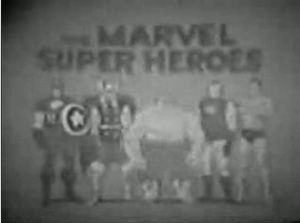|
Sixty-five episodes of three seven-minute segments were produced, for a total of 195 segments that ran initially in broadcast syndication from September 1, 1966 to December 1, 1966. The series, produced in color, had extremely limited animation produced by xerography, consisting of photocopied images taken directly from the comics and manipulated to minimize the need for animation production. The cartoons were presented as a series of static comic-strip panel images; generally the only movement involved the lips, when a character spoke, and the occasional arm or leg. Some animation fans have criticized the production as shoddy while noting that the series used the original stories largely in their entirety, showcasing classic Jack Kirby, Steve Ditko and Don Heck art, among others, from the period fans and historians call the Silver Age of comic books.
Stan Lee, Marvel's editor and art director at the time, said in 2004 that he believed publisher Martin Goodman negotiated the deal with Grantray-Lawrence and that Lawrence chose the characters to be used. Lawrence rented Lee and his wife a penthouse at 30 East 60th Street, near Madison Avenue, for Lee's use while he worked on the series. (Lee lived in Hewlett Harbor, New York, on Long Island, at the time.) Lee recalled, "I really don't remember any reaction from the Marvel artists involved. I wish I could claim to have written the [theme song] lyrics, because I think they're brilliant, but alas, I didn't".
Marvel announced the series in the "Marvel Bullpen Bulletins" of the November 1966 issues, stating in that monthly fan page's hyperbolic style that, "It won't be long before our swingin' super-heroes [sic] make their star-studded debut on TV, appearing five nights a week — that's right, five — count 'em — five nights a week, for a half-hour each night. So you've just got time to make sure your set's in good working order — check your local paper for time and station — and prepare to have a ball!
|

